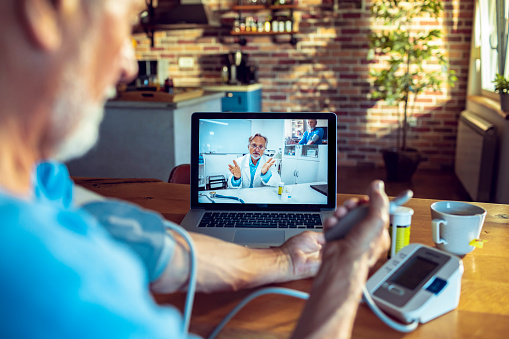Telemedicine – Opportunities and Challenges in the Wake of the COVID-19 Pandemic

Telemedicine – the provision of long-distance clinical healthcare, harnessing readily accessible health-related information and telecommunications technologies,[1] has seen a rather dramatic change over the course of the COVID-19 pandemic. In fact, it is one of the most tangible areas where the pandemic, which typically carries negative connotations, has had a positive impact.
Telemedicine has been around for quite some time, enjoying varying levels of acceptance and implementation, before COVID-19 has been introduced into our lives (in the U.S., for instance, its use had been quite minimal prior to COVID-19).[2] The virus, has been a major catalyst for the adoption of this already existing, skeptically-treated technology (due to various concerns related to autonomy, privacy, and physician-patient relationship).
This novel uptake of Telemedicine, modifies and challenges traditional healthcare delivery and consumption; changing in particular (even if temporarily), the nature of patient-physician relationship or interaction. The now wider implementation of Telemedicine, also has a professional-culture impact on the medical profession as such, and on medical practitioners’ self-determination and perception of their mission. In terms of a social impact, routinely embracing remote medicine is in fact aligned with society accustoming itself to remote, virtual consumption of almost anything (from goods and services, to education, leisure activities, and personal connections). In terms of the technology itself, Telemedicine has been contributing to the minimization of social gaps and inequalities, to some extent. Finally, the health tech industry has been booming in the face of a pandemic of such proportions.
This time of pandemic has seen the evolvement of Telemedicine’s prevalence: moving from relative rarity, to routine care practice. Since the advent of the pandemic, health care providers have experienced a significant shift towards the use of telemedicine for remote patient diagnosis, monitoring and treatment, including telepsychology.[3] These have been conducted through virtual e-consultations, and routine follow-up using home testing, namely: various kits and applications for self-testing and self-monitoring, communicating data back to the physician. This shift, is expected to revolutionize the health care industry. According to some reports, telehealth visits increased 300-fold during the months of March and April 2020, in comparison to the previous year, with adoption of telemedicine being consistent across adult age groups.[4]
Enabling, or facilitating the embrace of such change, was the removal of various financial and legal obstacles, such as: the relaxation of privacy protection rules in the U.S, and similarly – across Europe; introduction of various reimbursement models (e.g., in the U.S. – the updated provision of insurance coverage for remote medicine, to include virtual visits as well as video-based virtual tests[5]), and increased government funding for novel telehealth initiatives.[6]
In an attempt to characterize the evolution that Telemedicine – as an alternative means for healthcare delivery – has both gone through and inspired under the unusual circumstances of the present pandemic, we have identified elements of transition within these following features:
- Attitude
Namely, acceptance: shifting from technological skepticism voiced by medical ethics traditionalists and others (some even dubbing it a ‘disruptive innovation’[7]), to enthusiastic embrace by keen adopters. In fact, this fresh positive attitude towards Telemedicine, may have even gone beyond that of enthusiasm, to perceiving the technology as an object of desert or entitlement for anyone seeking healthcare. This could seemingly go as far as invoking a right to ‘digital-first’ primary care.
- Demand
Prompted by the aforesaid change in attitude, the once modestly-consumed healthcare technology, aimed mainly for treating and monitoring remote rural populations, has seen a considerable surge in demand during the COVID-19 pandemic.[8] The rising demand for Telemedicine services, due to the restrictive circumstances of the pandemic (e.g., high contagiousness, self-isolation, and quarantine), is complemented by a change in the optionality of digital services during such a time. In other words, we can similarly observe a shift from digital consumption (of Telemedicine services) by choice, to digital consumption by default.
- פרטיות
As for the nature of individual privacy concerns in the context of Telemedicine, it seems that we have somewhat moved from medical confidentiality as a focal point of contention (typical to pre-COVID Telemedicine critique), to discussions about the personal privacy, in its more intimate sense, of hospitalized and quarantined patients being continuously monitored through Telemedicine technologies. (Invoking, in turn, a paternalistic argument holding that one’s right to health, coupled with public health interests, occasionally trump the right to personal privacy.)
In terms of scope: it has been expanded to include not only individual privacy concerns, but also concerns pertaining to population health data, as Telemedicine’s usage has been extended to treat larger portions of the population, thereby gathering masses of health data for primary (clinical) and secondary (mainly, research) uses.
Also, as mentioned above, the better enablement of Telemedicine consumption has required, among other things, the relaxation of privacy protection rules. In the U.S., penalties for using HIPAA-noncompliant private communications technologies, were suspended,[9] thus facilitating the provision of Telemedicine services, by allowing physicians to communicate with patients, while being unrestricted to private settings (such as clinic or office), and using ‘non-public facing’ remote communication product (e.g., Apple FaceTime, Google Hangouts video, WhatsApp video chat, Zoom, typically employing end-to-end encryption).
- Purpose
Originally designed for treating remote populations, the dire circumstances society and the healthcare system are facing due to the pandemic have brought on geographic indifference, essentially allowing the use of Telemedicine to treat patients anywhere.[10] This shift may be better described as moving from a goal of promoting social justice by bringing good quality medicine to rural inhabitants, to one seeking to promote public health and safety in general.
A novel function of Telemedicine, created by the circumstances of the pandemic and perhaps somewhat exceeding its original purpose, is that of a patient personal communication tool. Its instrumental value is not limited to enabling quarantined patients to communicate with family (in addition to communication with medical staff), but extends to allowing them, in tragic circumstances, to realize their right to say goodbye to their loved ones.
Another (originally unforeseen) departure from Telemedicine’s original design, brought on by the COVID pandemic, is that of enabling not only quarantined patients’ access to healthcare, but also for quarantined physicians to deliver it from their home settings. This allows them to participate in the decision-making process regarding their patients, and share some of the overload experienced by on-site physicians.[11]
- Necessity
In terms of the essentiality of the technology, Telemedicine has shifted from its elective status as a personal healthcare service, to being a sine qua non public health tool.
- Benefits
Telemedicine’s original, rather modest instrumental value, as one benefitting individual patients in distant communities, has turned into a tool of a societal benefit. Telemedicine’s COVID-19-specific advantages and benefits include the following (non-exhaustive) list:
- Maintaining continuity of care (management of chronic conditions, or follow-up)
- Facilitating access to healthcare (particularly for handicapped, and at-risk patients)
- Promoting preventive medicine (allowing access to healthcare during pandemic for vulnerable and other populations)
- Reducing potential exposures to the COVID-19 virus
- Alleviating hospitals’ overload (through the usage of Telemedicine by first-aid services to provide a medical assessment, which could support home care to avoid hospitalization).[12]
- Other practical advantages include: meeting low workforce capacity (quarantined physicians’ participation via Telemedicine); and saving personal protective equipment (PPE) and medical supplies.
- Professional burden
The rising demand for Telemedicine, increased, in turn, professional overload. Once limitedly available to remote patients, the now unlimited availability of e-consultations – appears to increase medical workload for some healthcare providers.
Telemedicine, however, given its inherent limits, may serve as an imperfect substitute to traditional healthcare delivery, at least for some types of patients or areas of medicine, such as mental healthcare and physiotherapy. The personal interaction remains irreplaceable to a significant extent, in an intimate, delicately interwoven relationship between patient and therapist, such as in the former.[13] The physical touch is indispensable for evaluation, diagnosis and treatment, such as in the latter. Face-to-face consultation is defined by the WMA Statement on the Ethics of Telemedicine[14] as the gold standard of clinical care. The very idea of Telemedicine is, however, one that denies face-to-face healthcare, replacing it with a remote interaction via a virtual medical service. Consequently, the following sentiments, typically associated with a physician-patient relationship, may be lost in the transition to technology: trust, empathy, and intimacy, as well as the clinical goal of patient’s compliance.[15]
The nature of remote consultations is also inherently challenging for new physician-patient relationships, as it is not quite constructive for trust building. Additionally, it does not allow for a full, physical examination, or testing, to take place (irrespective of being well-acquainted with the patient, or not). Given the latter, Telemedicine is also an inappropriate instrument for close patient monitoring, where needed. It has also been argued that in terms of clinical efficiency, Telemedicine virtual visits are less focused and more time-consuming (lacking traditional on-site pre-work).[16]
Lastly, although originally intended to reduce socioeconomic gaps to a certain extent, Telemedicine’s reliance on technology (phones, computers, internet infrastructure, etc.), and its requirement of a fair level of digital literacy, may end up creating new barriers to healthcare access, thereby inadvertently enhancing social and racial inequality.[17]
Another seemingly trivial difficulty, but significant nonetheless, is one hinging on the personal circumstances of individuals seeking medical advice or treatment via Telemedicine, but lacking a ‘safe space’ from which they can privately and discreetly connect with their physician.
While admittedly, most of these cited shortcomings are not unique to Telemedicine in the narrow context of the COVID-19 pandemic, some of them may certainly be exacerbated by its associated circumstances, namely, quarantine and infection risk, consequently resigning patients to this presently irreplaceable healthcare route.
To sum, despite COVID-19’s wide-reaching implications for Telemedicine, extending to the point of the latter potentially becoming the new standard of care in some areas, it is difficult to accurately predict whether this medical trend will hold. While some current reports indicate that demand for virtual visits are plunging,[18] other estimates forecast the dramatic rise in the demand for telehealth technology, to persist over the next several years.[19] One can only assume that convenience through innovation will triumph to a certain extent, alongside the seemingly irreplaceable preference for (complementary) face-to-face physician-patient relationship/connection.
[1] https://www.hhs.gov/sites/default/files/telehealth-faqs-508.pdf; https://ilr.law.uiowa.edu/print/volume-99-issue-2/legislating-for-a-new-age-in-medicine-defining-the-telemedicine-standard-of-care-to-improve-healthcare-in-iowanew-article/.
[2] G. Weigel, A. Ramaswamy, L. Sobel, A. Salganicoff, J. Cubanski, and M. Freed, “Opportunities and Barriers for Telemedicine in the U.S. During the COVID-19 Emergency and Beyond”, Kff; https://www.kff.org/womens-health-policy/issue-brief/opportunities-and-barriers-for-telemedicine-in-the-u-s-during-the-covid-19-emergency-and-beyond/
[3] https://www.apa.org/monitor/2012/03/virtual
[4] Epic Health Research Network, “Expansion of Telehealth During COVID-19 Pandemic”, Ehrn.org (5 May 2020); https://ehrn.org/articles/expansion-of-telehealth-during-covid-19-pandemic
[5] Medicare Telemedicine Health Care Provider Fact Sheet, Cms.Gov; https://www.cms.gov/newsroom/fact-sheets/medicare-telemedicine-health-care-provider-fact-sheet
[6] N. Turner Lee, J. Karsten, and J. Roberts, “Removing regulatory barriers to telehealth before and after COVID-19”, Brookings.edu (May 6, 2020); https://www.brookings.edu/wp-content/uploads/2020/05/Removing-barriers-to-telehealth-before-and-after-COVID-19_PDF.pdf; Vital Signs: Digital Health Law Update, “Digital Health Dealmaking: Challenges and Opportunities”, Jdsupra (July 21, 2020); https://www.jdsupra.com/legalnews/vital-signs-digital-health-law-update-24098/.
[7] P. Yellowlees et al., “Disruptive Innovation: The Future of Healthcare?” 17(3) Telemedicine and e-Health, 231 (2011); https://www.researchgate.net/publication/50248824_Disruptive_Innovation_The_Future_of_Healthcare
[8] Leah Rosenbaum, “The Coronavirus Has Created A Surge of Telemedicine Demand. GoodRx Now Lets Consumers Compare Services”, Forbes (March 26, 2020); https://www.forbes.com/sites/leahrosenbaum/2020/03/26/the-coronavirus-has-created-a-surge-of-telemedicine-demand-goodrx-now-lets-consumers-compare-services/?sh=e97a1ff47f50
[9] FAQs on Telehealth and HIPAA during the COVID-19 nationwide public health emergency, Hhs.Gov https://www.hhs.gov/sites/default/files/telehealth-faqs-508.pdf
[10] See, in the U.S. – the Coronavirus Preparedness and Response Supplemental Appropriations Act: (Sec. 102) “This section allow HHS to temporarily waive certain Medicare restrictions and requirements regarding telehealth services during the coronavirus public health emergency”; https://www.congress.gov/bill/116th-congress/house-bill/6074.
[11] J. E. Hollander, and B. G. Carr, “Virtually Perfect? Telemedicine for Covid-19”, n. engl. j. med 382;18, 1679 (April 30, 2020).
[12] In Israel, an extensive such pilot was recently initiated by Magen David Adom – the Israeli Red Cross organization, with the cooperation of most of Israel’s HMO’s (health maintenance organizations).
[13] Arguably, while Telemedicine serves as a useful tool for sustaining therapist-patient interactions during a time of pandemic, it is not a panacea for people with mental health issues, requiring a personal, non-virtual connection with a professional therapist.
[14] https://www.wma.net/policies-post/wma-statement-on-the-ethics-of-telemedicine/
[15] https://www.ama-assn.org/practice-management/digital/help-patients-adjust-telehealth-remembering-human-touch; “telemedicine cannot yet, and most probably never will, entirely replace the benefits of being physically in the same room as your healthcare professional.” [Genetic Alliance UK] https://covid-19.geneticalliance.org.uk/wp-content/uploads/2020/07/Covid-19-Rare-Reality.pdf.
[16] A suggested solution to this shortcoming of Telemedicine, has been the soliciting of additional pre-visit information from patients through pre-visit surveys. See, G. Kriegel, S. Bell, T. Delbanco, and J. Walker, “Covid-19 as Innovation Accelerator: Cogenerating Telemedicine Visit Notes with Patients”, Nejm Catalyst (May 12, 2020); https://www.ncbi.nlm.nih.gov/pmc/articles/PMC7371295/.
[17] See WMA Statement on The Ethics of Telemedicine; https://www.wma.net/policies-post/wma-statement-on-the-ethics-of-telemedicine/;
[18] C. Ross,”Telehealth grew wildly popular amid Covid-19. Now visits are plunging, forcing providers to recalibrate”, Stat (September 1, 2020); https://www.statnews.com/2020/09/01/telehealth-visits-decline-covid19-hospitals/
[19] “Explosion in telehealth market due to COVID-19”, Health Europa (20th May 2020); https://www.healtheuropa.eu/explosion-in-telehealth-market-due-to-covid-19/100127/.



